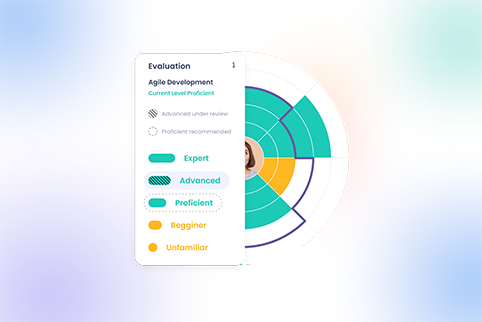70-20-10 Learning Model: Empowering Holistic Employee Development
10 min read

Resilience and flexibility are top priorities for organizations in today’s rapidly evolving business world. So, it’s only natural that various approaches, tools, and systems are considered when evaluating ways to nurture continuous learning. And while not new, the 70-20-10 learning and development model stands out as a powerful guiding framework for effective professional development.
Let’s embark on this journey together and explore the intricacies of the 70-20-10 model. By the end, you’ll know what makes this approach so effective and why it still has a place in today’s modern work environment.
Let’s dive right in!
What is the 70-20-10 learning and development model?
The 70-20-10 model is an approach to (professional) development that seeks to optimize the learning process and maximize its results by striking the right balance between different types of learning within an organization.
It is based on the work of three researchers, Morgan McCall, Michael M. Lombardo, and Robert A. Eichinger, who, at the time, were trying to identify the elements or key factors behind successful managers and executives. According to their findings, the optimal model involves:
- 70% experiential learning
- 20% social learning
- 10% formal learning
Why is the 70-20-10 learning and development model important?
The effectiveness of the 70-20-10 model, particularly in leadership development, is what makes it so important and still relevant nowadays, with various companies around the globe relying on it for their L&D or other business strategies.
Google, for example, implements this ratio but with a twist; it’s more focused on driving innovation, with employees being asked to spend:
- 70% of their time on core or job-specific tasks and responsibilities
- 20% of their time on projects that are related to their role
- 10% of their time on entirely new or unrelated skills, challenges, or projects
Another reason why you should consider the 70-20-10 framework is cost-effectiveness. By acknowledging that almost the entire learning process takes place on the job and through social interactions, you can optimize training budgets and allocate resources to smart internal initiatives, which rely more on collaboration and knowledge sharing rather than expensive (training) programs.
Of course, we also need to highlight that this development model helps employees develop skills that are both relevant and immediately applicable. Or, in other words, by its nature, the model ensures that your people’s growth is aligned with real business needs and capabilities that are in demand within the organization.

Components of the 70-20-10 learning and development model
Now, it’s time to take a closer look at the different types of learning that make up this model’s ratio:
70%: experiential learning
The huge focus placed on experiential or on-the-job learning comes from a simple but deep insight: people learn best by doing. This self-directed type of learning will support employees in developing and refining their job-specific skills. Recognizing this, companies that seek to implement this model of learning need to promote, encourage, and make as many ‘learn as you do’ opportunities available.
It needs to become an organization-wide initiative and even a mindset, at some level. In practice, it will look something like this:
- Provide hands-on training, which can start as soon as onboarding begins, thus helping newcomers adapt faster.
- Assign employees stretch assignments regularly enough that they are pushed to grow without feeling overwhelmed.
- Inspire managers to nurture strong individuals by allowing members of their team to figure things out by themselves and not always receive solutions from higher-ups.
- Encourage employees to take informal learning to the next level by using online resources (e.g., forums and communities, video sharing platforms, social media), where many types of skills can be learned or improved through personalized and self-paced individual study and exploration.
- Offer less traditional L&D opportunities, like job shadowing and rotations.
One of the most valuable benefits of embracing experiential learning is the immediate feedback, which arises in the flow of work, and helps your talent develop skills that are applicable and relevant to their current (and potentially future) tasks.
20%: social or environmental learning
According to the model, 20% of your employee’s growth happens during interactions with other members of the organization: peers, managers, business leaders, etc.
Unsurprisingly, the organizational culture plays a critical role in facilitating this type of learning, since it relies heavily on communication and direct interactions across hierarchical levels.
On the organization’s side, sharing knowledge should be encouraged and extended beyond formal discussions. Other ways of supporting social learning among your employees include:
- Encourage people to coach and mentor others or jump at the opportunity of being coached or mentored by more experienced colleagues.
- Create as many occasions for interactions, especially informal events like team lunches, game nights, and other social occasions.
- Adopt a growth mindset and ensure your leaders display the type of behavior that proves your organization appreciates and rewards experimentation and learning from mistakes.
- Leverage technologies to boost social learning and provide different platforms where people can share their findings and know-how beyond formal communication channels.
10%: formal learning
According to the 70-20-10 model, what we call formal or more traditional ways of learning are considered less important. This includes everything from studies and (online) courses to instructor-led training.
While this might have been surprising in the 1980s, when the research behind the model was done, it’s not big news nowadays. In fact, the reality that we are moving toward a skills-based and human-centric world of work is proved by huge corporations, including IBM, Accenture, Dell, and even Google, which have already begun dropping formal education requirements for various job openings.
However, this doesn’t necessarily mean that traditional education or training can’t provide any value. In fact, as we’ve highlighted in our article about employee growth opportunities, covering educational costs remains one-way companies support the development of their talent, with Amazon, Ford, or Disney standing out as examples among many others.
It’s important to be aware that 70:20:10 is a reference model and not a recipe. The numbers are not a rigid formula. They simply remind us of the facts above – that the majority of learning and development comes through experiential and social learning in the workplace (the ‘70’ and ‘20’) rather than through formal classes and courses (the ‘10’). Of course, structured and directed ‘formal’ learning can help, but it rarely, if ever, provides the complete answer.
— Charles Jennings, Founder of the 70:20:10 Institute
How to implement the 70-20-10 learning and development model in your organization
The 70-20-10 model isn’t a talent development strategy per se, but rather a framework you can use to prioritize and optimize L&D efforts. Below, we’ll list some of the steps HR departments and business leaders can take to implement it:
1. Assess organizational needs and L&D capabilities
The first step is understanding whether this learning model meets the short- and long-term objectives of your company. At this stage, you also need to evaluate whether the internal structure as a whole and especially that of the HR and L&D teams can support a 70-20-10 approach.
Keep in mind this doesn’t need to be a fixed formula. For example, Training Industry argues that instead of focusing on the ratios (70, 20, 10) you’re much better off splitting learning into 3 categories:
- On-the-job (O)
- Social (S)
- Formal (F)
The OSF ratio can then change accordingly based on the specific needs of each organization or even on the different needs of each department — something not at all unlikely, especially for large corporations.
2. Integrate the 70-20-10 model into your learning strategy
Having established that the model meets your needs, it’s time to look at the current strategy for talent development and see what adjustments need to be made to make the transition work.
For some, it will be easier than for others. If continuous learning is part of the company culture, you probably already have the social aspect covered. But for those with more fixed structures and clear divisions between silos, the process will involve more significant changes.
Since the management and development of talent always need to be in alignment with the direction of the company, make sure key stakeholders and business leaders are on board with the changes. The transition will be more challenging without their support and it can even create confusion among employees.
3. Announce and explain the new model
The next step is communicating the planned changes, together with a detailed timeline and the reasoning behind this shift in the L&D approach. It’s the perfect moment to ensure everyone understands the importance of experiential and social learning and address any questions or concerns regarding the transition.
While employees will reap most of the benefits, L&D specialists, managers, and internal coaches (if any) are most likely to be the ones requiring additional support or training.
For some, it will be a distinct departure from the current way of doing things, and adopting a more coaching or in-the-flow approach to development won’t be easy. Still, their impact and role in the 70-20-10 framework is crucial, which is why they should receive all the necessary resources and guidance.
4. Implement specific initiatives to support the new approach to learning
Here, it’s all about adding the talent and development opportunities required to make the 70-20-10 model a success. Most often, this step involves creating or expanding less traditional initiatives, like job shadowing, mentoring programs, cross-functional projects, and so on.
Perhaps the best way to make them all visible and easily accessible by employees is through an internal talent marketplace — a modern platform where anyone inside your organization can see what development opportunities are available and how they align with their current skills and future career goals.
This talent marketplace will be especially beneficial for providing and promoting many types of learning opportunities from the 70 and 20 categories: from temporary roles and cross-departmental teams tackling specific projects to structured coaching or mentorship aimed at preparing the company’s future leaders.
5. Evaluate the impact of the 70-20-10 model
Using clear KPIs (established before the transition) will reveal if the new learning model meets the expectations in terms of impact and improved results. Some of the metrics that should be on your list include:
- progress on skills development
- overall measurable improvement in performance
- increase/decrease in satisfaction and engagement after the implementation
- enhanced ROI and reduced costs, since the model relies more on internal resources
- uninterrupted workflow/lack of critical pain points reported by HR and L&D after the change
6. Gather feedback and improve the process
Regular reviews shouldn’t focus only on the success of this new model, but also on the learning programs themselves — the framework might be good, but the selected growth resources could simply fail to deliver.
When making changes to the model, always start from your organizational needs and take a careful look at feedback from employees who have been impacted the most by the new changes.
Final thoughts
The 70-20-10 learning and development model isn’t a new concept. However, it acts as a stable framework toward a more holistic learning process, which ensures both employees and companies remain adaptable and innovative — fundamental qualities in today’s world.
If implemented well and adapted to the specific needs of each organization, this model will foster growth by leveraging the fact that the most potent lessons are learned through a dynamic blend of doing, sharing, and balancing various types of learning.
At Nestor, we support the 70-20-10 model through a wide range of features. With our talent marketplace, you’ll easily align employee development with business needs using the power of skills, ensuring the most relevant learning opportunities (70, 20, or 10) are available to each individual.
Our People Intelligence Platform also provides quick and easy access to real-time data on skill development, enabling decision-makers and people managers to adjust growth and career plans accordingly. Want to learn more?







